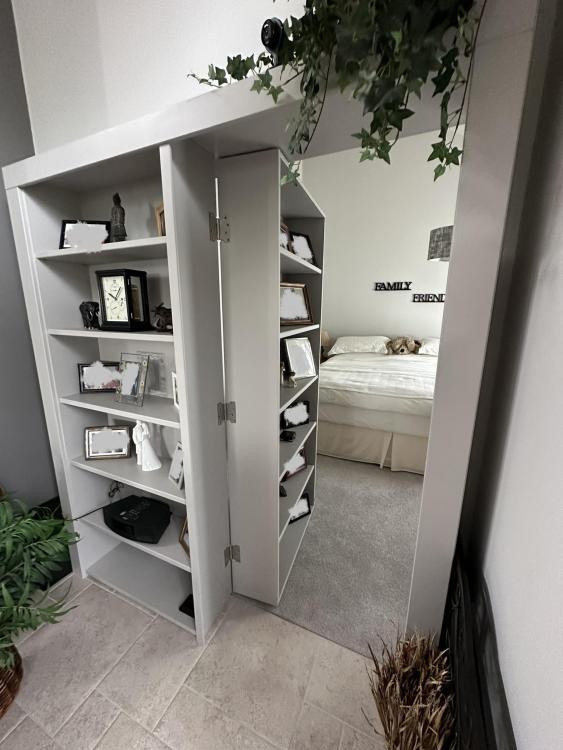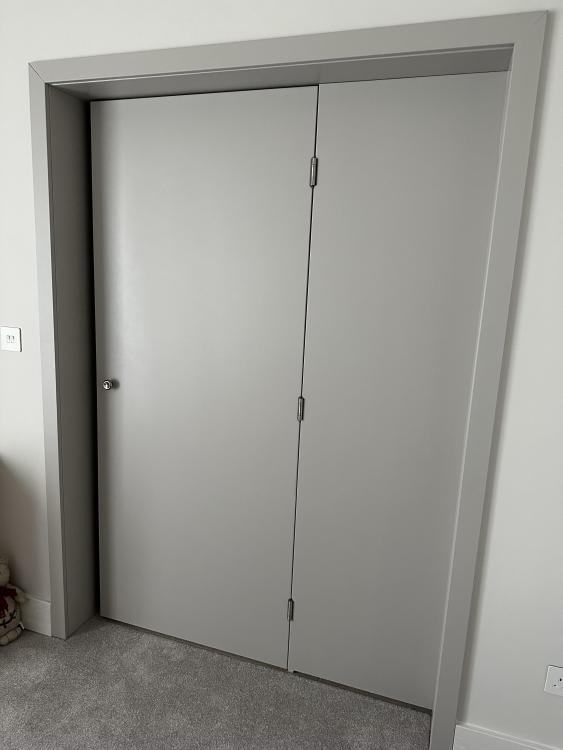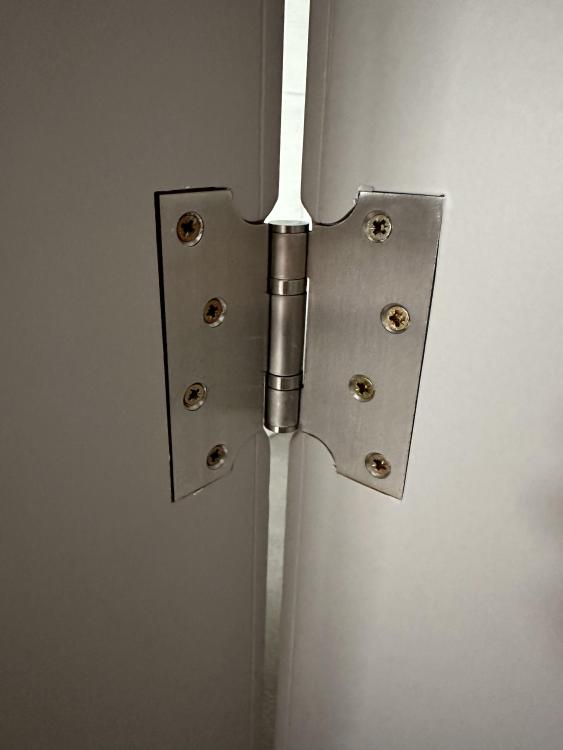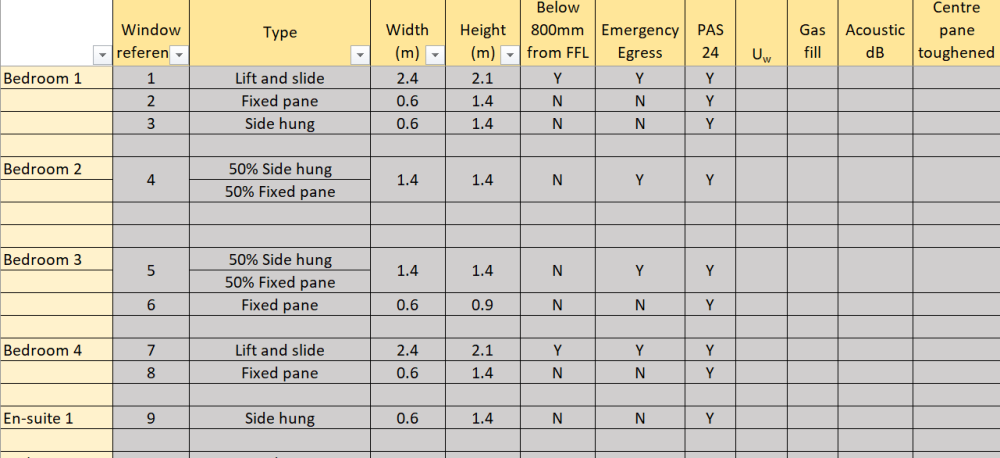Leaderboard
Popular Content
Showing content with the highest reputation on 05/24/23 in all areas
-
3 points
-
Yes, the datasheet specifically states that the drain-gate capacitance of the switching FET will cause it to turn fully on before the control circuitry has stabilized. A series inductor could be used In order to slow the rising edge to greater than 5us and not load the PWM driver (rather than using a parallel capacitor).2 points
-
2 points
-
I’d say so. Do that shopping around and find someone who at least knows something about one of the disciplines, preferably both.2 points
-
Glass for the three sets of sliders is being delivered Friday morning I look after our first grandchild on a Friday morning So I’ll Bob back at the end of day and put the glass in Which will mean we are fully watertight I’ve also one low roof to add two Velux and finish slating over the weekend But I’ve already purchased those I’ve had a tot up tonight and have spent 195k on 420m2 including the two story workshop I didn’t count the garage in our last build but have this time as it’s cavity wall insulated Attic trusses slated and wet dashed stairs Identical to the house But with limited fit out I’ve the treatment plant in All drains including a 60 meter run across our field to the dyke All window including three sets of sliders and one French doors Front and back are temps 50 quid Scaf hire is settled also I’ve allowed 150k to fit out which should be sufficient So not a million miles off our original predicted spend Picture was going to be of a boring old nowhere near complete house 😁2 points
-
Whilst you can learn as you go along It’s not ideal for your Architect to do the same As you will be paying him The design will need to take your specific build into account Might be worth shopping around2 points
-
I had no experience or knowledge. My architect had no experience or knowledge. Yet here I am 😊 You got this ! Plans please !!! 👍2 points
-
Too right! Hi Alan. Hope this helps... there is a lot of prep work you can do.. seems like you have already started raking out a borehole log so well done. We call this a desktop study, often folk slag this off but what they don't know is that it forms part of the BS design codes to site investigation and good practice. Try and find out as much info as you can online, look at the BGS viewer to see what kind of bedrock you have and superficial deposits. Speak to the neighbours (very good to do as we weave this local knowledge into a site investigation report), well I do as it carries weight.. believe it or not. Ask say about flooding, were there any landfill sites, was it in a bad corner of a field that the farmer filled in? .. think of the things that might be relevant to your site, be friendly and get them talking. Sometimes they produce old historic photos and give you pointers, history of the site and real nuggets of info that can literally save thousands later on. Other stuff.. have a look at the services, if rural... then where are they, what services will you need.. drainage is a biggy. If in the town.. where do you think they might be and how deep to the sewer in the street, if rural have you available space for say a soakaway or easy access to a water course that does not dry up in the summer.. Next thing to do is to have several walk overs of the site and wander round about. Try and understand how the topography has been formed and importantly what has been changed over time. Are there culverts, how does the land drain, where are the water courses, are there big trees, if so which way are they leaning.. If you see the power company / water folk digging up the street stop and ask them about the ground! many of them are keen to tell folk what they know!.. sleep on stuff for a while.. be curious.. think of everything you can and try and work out why the things you observe are the way they are.. and write it down. The objective of the above is to try and encourage you to look outwith the site and understand what is going on round about. Do your best here and put all the info you have into a document with some photos. Now you have the makings of a desktop study and off the back of that you then plan the intrusive site investigation. Your SE and investigation company will meet you with open arms if you turn up well prepared and won't make a fool of your efforts.. if they do then find another SE GI company pronto. If you come to me and say Gus.. I want to build this house.. I'll say.. to do it right and do our best to avoid things coming back to bite us we need to start with the above. This way we take all reasonable steps to mitigate the risk to you and we can then focus our effort on the different designs knowing we have started out doing things the right way.. done the leg work. The above is the starting point of planning an intrusive investigation that reduces the risk of wasting money while at the same time providing useful design information that can unlock options for the building / basement.2 points
-
Finally made a start in earnest. The original plan was to stick build on site, but the cabin builds opened my eyes to the winds up here, and established concern for getting the house airtight. I priced ICF, and although the costs are higher in the begining I think, I can self build for similar money, but get a far superior product. This is a budget build, most of the nice to haves have been dropped. The only redline is we want to ensure this is future proof, so all on the ground floor. Around 12 months ago the area where the house is going was stripped down to bedrock. The initial plan was a DIY insulated raft, but the move to ICF opened up a more traditional strip footing using the ICF. Back in February we hired a 360 with a pecker to break out some of the rock to lower the NE corner, as the bed rock slopes to the SW. Bed rock exposed looking East NE corner We broke out and removed around 400mm of rock along the W and N elevations, the break out got shallower towards the SW corner. The main aim here was to reduce the height of the house on the SW corner, we will be bringing the ground level up to minimise the impact. We also need to strip some rock of the slab area to allow for the 300mm insulation. This week, thanks to an understanding BC officer, ( still waiting for the revised certificate of design to change the building warrant, but he's happy for me to proceed with the old warrant for the time being👍❤️). We made a start preparing. The plan is to shutter the strip foundation. First step was to level the strip with layers of compacted 40mm to dust stone, and also level the bedrock for the slab. Ready for stone looking W Starting on the North trench we barrow in the stone and compact. Adding more stone in layers and compacting, the backhoe loader was doing some of the grunt, but the leveling was all by hand, 100mm layers at time. looking NE Took the decision to build the sub slab to what will be the same level as the strip footing, this allows for the Radon barrier to be put under the strip up the side and then on top of this sub slab, then all services will be above the radon barrier and below the insulation in another layer of compacted hardcore. The main reason for, what will be a fiddly taks of having the radon barrier under the strip, is that the strip footing has 288 starter rebars and sealing these penetrations would be worse. Once the strip is poured we will finish of the back filling and install the radon barrier. More stone looking East So 5 days in me and Mandy have moved levelled and compacted 70T on 40mm to dust. And around 5 ton of quarry dust, this is used up here as an alternative to grit sand for blinding and pipe bedding. The shuttering is 150*50 timber that will be leveled then the radon barrier folded to form a tray, later to be joined to the slab. I'm going to use 6mm threaded rods to link the two shutters together, preventing any spread when the concrete is poured. Hopefully next week the ICF arrives, in I've got a 10 hour round trip to collect rebar. For a tank of fuel and a days driving I can save around £500 collecting from Central rebar in Aloa. For info, £930+ / ton direct Inverness suppliers (100miles away) we're after between 1250 & 1500/ton plus delivery charges ranging from £200 / £350 plus vat.1 point
-
One for @Gus Potter I think. Had a quick look, Cord 1 and 1 (top and bottom) have similar dead loads at 210 and 200 N.m-2, so that is 410 N.m-2 for flooring and ceiling. The there is the imposed load, which I think is point loading, at 1500 N.m-2, which is 159 kg.m-2. My knowledge is lacking in that I do not know for definite what the imposed load it. Seems from a very quick internet search that they are considered equal to impact loads. https://eng.libretexts.org/Bookshelves/Civil_Engineering/Structural_Analysis_(Udoeyo)/01%3A_Chapters/1.02%3A_Structural_Loads_and_Loading_System1 point
-
Absolutely brilliant and makes so much sense in the wasted space of some doorways. I wonder if you could somehow make a fire door version. Storage in the utility room and then access to the garage.1 point
-
If you have a cavity tray,you can take the corner bricks out,leave the odd brick out along each run (say every couple of metres) and rod any mortar droppings with a length of batten from each end. Best to do it before it sets though-if you need to get vigorous you risk damaging the tray. Or (my preferred option) use full fill cavity batts & everyone’s a winner 😀1 point
-
Hi there, I’ll take a look at car turning but it might be a 15 point turn!! If you look at the floor plan you’ll see a triangular section of wall at each end of the building. This is to create the recess but at the same time to give a solid end wall. ETC.1 point
-
1 point
-
Where @Jenki is, there are not many days when the wind is low enough for midges to bother you.1 point
-
Hang the speaker with a gripple hanger or something to take the weight1 point
-
1 point
-
does this maths seem correct? 18lm x 0.37kg = 6.66kg / 16.32m2 = 0.41kg/m2 if so, that's nothing! and so with those maths the MF ceiling won't add any extra load i just need to figure out if i can double board with 12.5mm PB and not exceed the 200N/m2 maximum load of the bottom chord. maybe i should post this in boffins corner so all the boffins see it? otherwise it's just me and @pocster bumbling through as usual.1 point
-
I've seen some blocks omitted every so often to allow final clean out, then a block slid in to close, thinking about it, I think they actually put the block in with a very weak mortar so it could just be easily dug out. The walls were not big (max 4m long) and they got in and pulled out most of the slops. Other options may exist, thinking of my build, I can sort of get into bits of my cavity from the solum through the vent sleeves that go through the inner leaf - if I wanted I could have had more of a honeycomb affair which would have allowed clean out. There will be lots of options from vent-bricks that are left out to other access points. Another option, and one I firmly believes exists, is a skilled brickie who will drop very little down the cavity. Our brickie who has built everything for us, laid our cavity wall blockwork with a bed and mortar mix which just squeezed out and left a slight bump and when it did go a bit further it always seemed to stay put. If the mix is a bit sloppy, you're going to get lots of slop so a good mix is key, and a good brickie who is good at putting down a bed should not really be putting so much mortar down that it is squeezing out enough to fall constantly. On a new straight and level build with good coursing the bed should be pretty consistent and should not be so deep as to be wasteful.1 point
-
As long as you get a 5 port or 5 terminal meter, it will do that. The 5th terminal is the output that is only energised when it is at the cheap rate. But Smart meters have come along and messed things up. You can aparently get a 5 port smart meter, but not all suppliers seem capable of actually making them do what it says on the tin, and lots of horror stories of the 5th output not turning on and off or the metering times matching the switching times. So if you do switch, ask for Economy 7 or preferably Economy 10 if available and don't mention smart meter and if that comes up in discussion say you don't want one. You will ideally need 2 immersion heaters one to come on whenever the cheap rate is available at the bottom of the tank, and another you can turn on at any time for a boost. If your tank will only take 1, then Horstman do a clever gadget that will let one work from the off peak supply with a manual timed boost.1 point
-
Mate ! I know (expletive deleted) all Yet I am ( still ) building a mostly underground house with all the issues that entails . Ignorance is bliss . Many have said “ you don’t know what you don’t know “ If I had understood everything from the start then a) I’m a seasoned pro and it’s easy b) (expletive deleted) that ! 😁😎 . What’s life without adventure and risk ? ( ignoring all the shit bits of course ) .1 point
-
this is the TV room on the ground floor. basement comes much later. need to get the main house finished first. don't want to end up a lifer like you. 😉1 point
-
@nodThank you very much. I think you are right. @pocsterthanks for the encouragement but it just doesn’t feel like I’ve “got this” right now 😀. Plans coming up1 point
-
I can always print covers up if you make a hash of the joints.1 point
-
A ballpark for you - a new pole and stays, de-rigging a single phase overhead about 50m long, and replacing with about the same length of underground including digging was £16.2K. It's less if you organise the trench digging yourself. This was UKPN, but I think they're all similar - although there are some tales on BH of people getting sympathetic treatment from their DNO. >>> NPower regs needs to be 5 M away from buildings I think there are some provisions for temporary moves and also temporary protection of cables during the build process if that helps any. >>> the woman who lived in the rikkety house had signed a deal with the devil for a few quid to have a pole in the garden and comes with an easement. It's worth double checking whether this binds you to this same arrangement. My understanding is that if it's a simple contract (rather a deed registered with the Land Registry) it probably doesn't. However, making the DNO aware of their lack of rights and then getting them to do something about it may take years. OTOH if you have a sympathetic DNO, it may not. I guess in all circumstances, asking the DNO for costs and timescale (and the best way to reduce both) won't hurt any.1 point
-
Welcome. lots of advise one here. We were where you were 3 1/2 years ago, with a quote for £40k for electric supply. Said it before on here, but it was almost stopping point, as that was the contingency gone, before we'd started. In the end we couldn't bear someone else building "our house" and us having to start again. Moved in last July. The important thing about the foundations is to plan for the extra, Our take off from the original drawing the SE provided was 28m3 concrete and by the time we'd finished due to finding old tree stumps in the ground clearance we ended putting in 69m3 So that cost us about £6k because we had the correct agreement in place with the ground worker. With out that agreement in place, there would have been lots of "more work" "more concrete" "15 - 20k". Worth popping up a redacted / anonymised sketch of your plot, there may be some contestable works you can do to move the cable underground. Is this an easement or wayleave and who with? Did your solicitor not pick this up in the searches ?1 point
-
>>> Soudal Silirub 2 Thanks Craig - I used this silicone and like it . It flows fairly easily which I liked.1 point
-
1 point
-
50 bean seeds planted. 47 new seeds and 3 saved from last year. Rather than last years paper mache/compressed cardboard pots, I've used compostable espresso cups I got given for nothing. I just punched a single hole in the base. It's taken 13 days for the seedlings to appear as opposed to 9 days last year. Not helped by the cloudy and wet month we've had here along with some morning frosts still.1 point
-
Yes, it uses Log curve. DALI defines 45% as about 2.2%. The Meanwell driver goes down to 0.2% and the EldoLED down to 0.1%. Of course, while 2% seems low, from a perceived light perspective it's still quite bright and not ideal for this weird dimming behaviour as observed to happen.1 point
-
I find a jumper is the most eco thing. Some people's houses are so hot and then they complain to me their gas bill was £200 a month..1 point
-
1 point
-
There is a legal framework known as the measured duty of care which may be relevant. I had a similar issue with a neighbor's retaining wall (or lack of one to be precise) and mentioned that he had a "legal duty of care" regarding his collapsing ground and this prompted him to erect a retaining wall on his side of the boundary.1 point
-
I've never found a good sander, always seem pretty rubbish. I find a good scraper is way better, then just use the sander for finishing off.1 point
-
The Celotex U-Value Calculator goes up to 200mm Perimeter 0.3 100mm 0.16 150mm 0.12 165mm 0.11 200mm 0.091 point
-
I've had a few lidl/aldi tools that were a bit feeble. Others good. So I would want to see reviews. Sanding can be tedious and slow with poor kit. For economy I would prefer wickes stuff which can be basic but works. I always wondered if this was Draper with a different label as it is similar in target market. Next jump to a big brand. Double the cost, probably better and faster.1 point
-
I'd get the parkside from Lidl or the Aldi equivalent. Competent and adequate tools.1 point
-
Quarter sheet one. Gets more pressure on the paint, and easier to get into corners.1 point
-
only just seen this thread with this recent resurrection....has made me chuckle this morning, thank you. 🙂1 point
-
Pretty sure you can get fire rated plasterboard to bring that down. It’s the pink plasterboard I think.1 point
-
Using a property managment/maintenence company for an extension was your initial mistake. Should of found an actual builder on recommendation. Decent builder won't want to build something that is restricted in height or doesn't work well for the client and would of looked for a work around. You seem pretty on the ball and sounds like you could of managed a builder well rather than leaving it to some shoddy company. You will get this resolved soon and once done and dusted will all be worth it.1 point
-
Good riddance to the THTC tariff. It was a good idea in it's time, the chief advantage being the "total control" circuits being metered 24/7 at the cheap rate. But it became a very expensive tariff and with only SSE offering it there was no competition and you could not switch supplier. To convert, all you need is a simple Economy 7 or economy 10 supply with a 5 port meter, the 5th port being the SWITCHED off peak output. Economy 10 if you can get it is the best match to the old off peak times of THTC. The only thing you will need an electrician to do is then connect the total control circuits to the normal permanent supply. You will miss out on the 24/7 cheap rate which could have powered panel heaters or showers. Did you actually take advantage of that, or were you just using ordinary storage heaters?1 point
-
1 point
-
Or here they are doing it with wood, possibly fencing arris rails. Perhaps worth watching the whole series.1 point
-
I read that link, was dismayed, and even got as far as trying to respond but was even more dismayed. This is all about more red tape, more rules, more paperwork for installers etc. This will do NOTHING to speed up the rate of heat pump installs. Typical government mentality, regulate everything, even though we have a PM who says he is in favour of the opposite. I gave up the will after the first few questions trying to respond, it is only looking for answers to approve their plans or make minor alterations to them. What I wanted to say is the whole plan is a crock of steaming excrement, it just burdens the market with yet more paperwork and expenses and ensures is is just the big companies who are set up to milk the system and collect the grant money that will operate in this type of market. What is needed is less and simpler regulation and to encourage the small plumbing end electrical businesses, even sole traders, to be involved in heat pump installation. That is the only way you will get the thousands of electricians and plumbers we already have on board and installing heat pumps.1 point
-
1 point
-
If I've understood what you want I would replace the boundary wall at the courtyard with a new wall inline with their parapet wall. Yes I know it means sacrificing 2" or so but sometimes going for the neat and tidy option is best. Especially where waterproofing is involved. This approach would mean all the rafters would be same length an angle. No joggle/step in the gutter. Then I would copy their roof but mirrored over and longer to fill in the courtyard area. Their lead work looks a bit untidy at the ends (?) but the joints on the parapet wall looks neatly done to my eye. Lead flashing and secret gutters are tricky to get right and some builders just can't seem to do it. I would suggest getting a detail drawing done for this area, possibly by a dedicated lead worker? Make sure the builder follows his drawing and has him come back to do the lead work.1 point
-
Why are you doing on-roof on a new build? You'll save the cost of a lot of tiles, and a bunch of maintenance headaches, by going in-roof rather than on roof. Do you have a number for total heat demand kWh/m2/year ? Walls and window U value alone only tell a fraction of the story. Floor, roof, quantity of glazing, and airtightness level all play just as big a part.1 point
-
If you need 4kW PV to pass your SAP, you really need to take a look at the insulation you are putting in, it must less than than the bare minimum.1 point
-
We used the following wording: This letter is notification of exemption of Approved Document R. The proposed dwelling is in an isolated area and is isolated from a relevant connection. Please see page 4 point 1.7 of Approved Document R Volume 1 2022 edition for further information, this is also quoted below. “Where a developer seeks to rely on the building being in an ‘isolated area’ as a reason to exempt new dwellings from requirement RA1, the developer must provide evidence in support of the exemption. This should include an explanation of how new dwellings are in an area that is isolated from a relevant connection, that the cost of providing a USO-standard public electronic communications network connection exceeds the cost cap and why the prospect of a connection to a relevant network in the isolated area is considered too remote to justify equipping the building with the relevant gigabit-ready physical infrastructure. The application of this exemption will vary in different circumstances.” We have attached screen shots from various major providers each stating that full fibre is not available in the area currently. And attached screenshots from City Fibre / BT / Virgin showing cant supply Fibre1 point
















